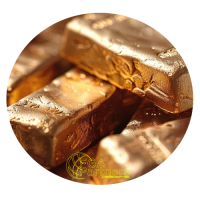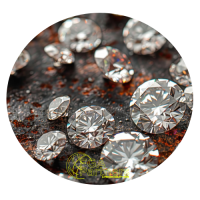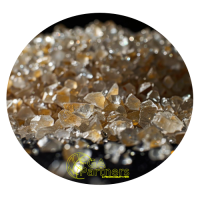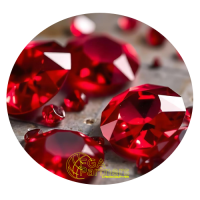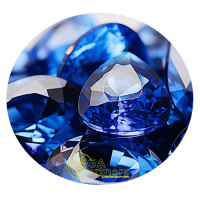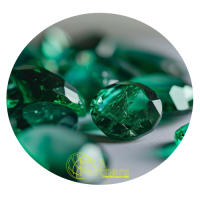Emeralds
We work with both verified buyers and sellers of emeralds globally. Contact us to arrange for a discovery call.
Here is a little history of Emeralds and what has attracted people to them for thousands of years.
Emeralds are fascinating gemstones. They have the most beautiful, most intense and most radiant green that can possibly be imagined: emerald green. Inclusions are tolerated. In top quality, fine emeralds are even more valuable than diamonds.
The name emerald comes from the Greek ‘smaragdos’ via the Old French ‘esmeralde’, and really just means ‘green gemstone’. Innumerable fantastic stories have grown up around this magnificent gem. The Incas and Aztecs of South America, where the best emeralds are still found today, regarded the emerald as a holy gemstone. However, probably the oldest known finds were once made near the Red Sea in Egypt. Having said that, these gemstone mines, already exploited by Egyptian pharaohs between 3000 and 1500 B.C. and later referred to as ‘Cleopatra’s Mines’, had already been exhausted by the time they were rediscovered in the early 19th century.
Written many centuries ago, the Vedas, the holy scriptures of the Indians, say of the precious green gems and their healing properties: ‘Emeralds promise good luck …’; and ‘The emerald enhances the well-being …’. So it was no wonder that the treasure chests of Indian maharajas and maharanis contained wonderful emeralds. One of the world’s largest is the so-called ‘Mogul Emerald’. It dates from 1695, emerald weighs 217.80 carats, and is some 10cm tall. One side of it is inscribed with prayer texts, and engraved on the other there are magnificent floral ornaments. This legendary emerald was auctioned by Christie’s of London to an unidentified buyer for 2.2m US Dollars on September 28th 2001.
Emeralds have been held in high esteem since ancient times. For that reason, some of the most famous emeralds are to be seen in museums and collections. The New York Museum of Natural History, for example, has an exhibit in which a cup made of pure emerald which belonged to the Emperor Jehangir is shown next to the ‘Patricia’, one of the largest Colombian emerald crystals, which weighs 632 carats. The collection of the Bank of Bogota includes five valuable emerald crystals with weights of between 220 and 1796 carats, and splendid emeralds also form part of the Iranian National Treasury, adorning, for example, the diadem of the former Empress Farah. The Turkish sultans also loved emeralds. In Istanbul’s Topkapi Palace there are exhibits with items of jewelry, writing-implements and daggers, each lavishly adorned with emeralds and other gems.
The green of the emerald is the color of life and of the springtime, which comes round again and again. But it has also, for centuries, been the color of beauty and of constant love. In ancient Rome, green was the color of Venus, the goddess of beauty and love. And today, this color still occupies a special position in many cultures and religions. Green, for example, is the holy color of Islam. Many of the states of the Arab League have green in their flags as a symbol of the unity of their faith. Yet this color has a high status in the Catholic Church too, where green is regarded as the most natural and the most elemental of the liturgical colors.
The magnificent green of the emerald is a color which conveys harmony, love of Nature and elemental joie de vivre. The human eye can never see enough of this unique color. Pliny commented that green gladdened the eye without tiring it. Green is perceived as fresh and vivid, never as monotonous. And in view of the fact that this color always changes somewhat between the bright light of day and the artificial light of a lamp, emerald green retains its lively vigor in all its nuances.
The lively luminosity of its color makes the emerald a unique gemstone. However, really good quality is fairly rare, with inclusions often marring the evenness of the color signs of the turbulent genesis which has characterized this gemstone. Fine inclusions, however, do not by any means diminish the high regard in which it is held. On the contrary: even with inclusions, an emerald in a deep, lively green still has a much higher value than an almost flawless emerald whose color is paler. Affectionately, and rather poetically, the specialists call the numerous crystal inclusions, cracks or fissures which are typical of this gemstone ‘jardin’. They regard the tender little green plants in the emerald garden as features of the identity of a gem which has grown naturally.
So where do they come from and how is it that they exist at all? In order to answer these questions, we need to look far, far back into the time of the emerald’s origin. Emeralds from Zimbabwe are among the oldest gemstones anywhere in the world. They were already growing 2600 million years ago, whilst some specimens from Pakistan, for example, are a mere 9 million years young. From a chemical-mineralogical point of view, emeralds are beryllium-aluminum-silicates with a good hardness of 7.5 to 8, and belong, like the light blue aquamarine, the tender pink morganite, the golden heliodor and the pale green beryl, to the large gemstone family of the beryls. Pure beryl is colorless. The colors do not occur until traces of some other element are added. In the case of the emerald, it is mainly traces of chromium and vanadium which are responsible for the fascinating color. Normally, these elements are concentrated in quite different parts of the Earth’s crust to beryllium, so the emerald should, strictly speaking, perhaps not exist at all. But during intensive tectonic processes such as orogenesis, metamorphism, emergences and erosion of the land, these contrasting elements found each other and crystallized out to make one of our most beautiful gemstones. The tension involved in the geological conditions conducive to the above processes produced some minor flaws, and some major ones. A glance through the magnifying-glass or microscope into the interior of an emerald tells us something about the eventful genesis of this unique gem: here we see small or large fissures; here the sparkle of a mini-crystal or a small bubble; here shapes of all kinds. While the crystals were still growing, some of these manifestations had the chance to ‘heal’, and thus the jagged three-phase inclusions typical of Colombian emeralds were formed: cavities filled with fluid, which often also contain a small bubble of gas and some tiny crystals.
Logically enough, a genesis as turbulent as that of the emerald impedes the undisturbed formation of large, flawless crystals. For this reason, it is only seldom that a large emerald with good color and good transparency is found. That is why fine emeralds are so valuable. But for the very reason that the emerald has such a stormy past, it is surely entitled to show it – that is, as long as only a fine jardin is to be seen, and not a rank garden which spoils both color and transparency.
Colombia continues to be at the top of the list in terms of the countries in which fine emeralds are found. It has about 150 known deposits, though not all of these are currently being exploited. The best known names are Muzo and Chivor, where emeralds were mined by the Incas in pre-Columbian times. In economic terms, the most important mine is at Coscuez, where some 60 faces are being worked. According to estimates, approximately three quarters of Colombia’s emerald production now comes from the Coscuez Mine. Colombian emeralds differ from emeralds from other deposits in that they have an especially fine, shining emerald green unimpaired by any kind of bluish tint. The colour may vary slightly from find to find. This fascinatingly beautiful color is so highly esteemed in the international emerald trade that even obvious inclusions are regarded as acceptable. But Colombia has yet more to offer: now and then the Colombian emerald mines throw up rarities such as Trapiche emeralds with their six rays emanating from the center which resemble the spokes of a millwheel.
Even if many of the best emeralds are undisputedly of Colombian origin, the ‘birthplace’ of a stone is never an absolute guarantee of its immaculate quality. Fine emeralds are also found in other countries, such as Zambia, Brazil, Zimbabwe, Madagascar, Pakistan, India, Afghanistan and Russia. Zambia, Zimbabwe and Brazil in particular have a good reputation for fine emeralds in the international trade. Excellent emerald crystals in a beautiful, deep emerald green and with good transparency come from Zambia. Their color is mostly darker than that of Colombian emeralds and often has a fine, slightly bluish undertone. Emeralds which are mostly smaller, but very fine, in a vivacious, intense green come from Zimbabwe’s famous Sandawana Mine, and they often have a delicate yellowish-green nuance. And the famous emerald mines of Colombia currently face competition from right next door: Brazil’s gemstone mine Nova Era also produces emeralds in beautiful green tones, and if they are less attractive than those of their famous neighbor it is only by a small margin. Brazil also supplies rare emerald cat’s eyes and extremely rare emeralds with a six-spoked star. Thanks to the finds in Africa and Brazil, there are more emeralds on the market now than there used to be – to the delight of emerald enthusiasts – .
While its good hardness protects the emerald to a large extent from scratches, its brittleness and its many fissures can make cutting, setting and cleaning rather difficult. Even for a skilled gem cutter, cutting emeralds presents a special challenge, firstly because of the high value of the raw crystals, and secondly because of the frequent inclusions. However, this does not detract from the cutters’ love of this unique gem. Indeed, they have developed a special cut just for this gem: the emerald cut. The clear design of this rectangular or square cut with its beveled corners brings out the beauty of this valuable gemstone to the full, at the same time protecting it from mechanical strain.
Emeralds are also cut in many other, mainly classical shapes, but if the raw material contains a large number of inclusions, it may often be cut into a gently rounded cabochon, or into one of the emerald beads which are so popular in India.
Today, many emeralds are enhanced with colorless oils or resins. This is a general trade practice, but it does have the consequence that these green treasures react very sensitively to inappropriate treatment. For example, they cannot be cleaned in an ultrasonic bath. The substances that may have been used by the cutter during his work, or applied subsequently, seal the fine pores in the surface of the gem. Removing them will end up giving the stone a matt appearance. For this reason, emerald rings should always be taken off before the wearer puts his or her hands in water containing cleansing agent.
Unfortunately, because the emerald is not only one of the most beautiful gemstones, but also one of the most valuable, there are innumerable synthetics and imitations. So how can you protect yourself from these ‘fakes’? Well, the best way is to buy from a specialist in whom you have confidence. Large emeralds in particular should only be purchased with a report from a reputable gemological institute. Such an institute will be able, thanks to the most modern examination techniques, to differentiate reliably between natural and synthetic emeralds, and will inform you as to whether the stone has undergone any treatment of the kind a purchaser has the right to know about.
And one more piece of advice on the purchase of an emerald: whilst diamonds generously scintillate their fire in sizes below 1 carat, you should go for larger dimensions when acquiring a colored gemstone. True, there are some lovely pieces of jewelry with small colored gems to set decorative accents, but emeralds, like other colored gemstones, do not really begin to show that beautiful glow below a certain size. How large ‘your’ emerald ends up will depend on your personal taste, and on your budget. Really large specimens of top quality are rare. This means that the price of a top-quality emerald may be higher than that of a diamond of the same weight. The fascination exuded by a fine emerald is simply unique.
